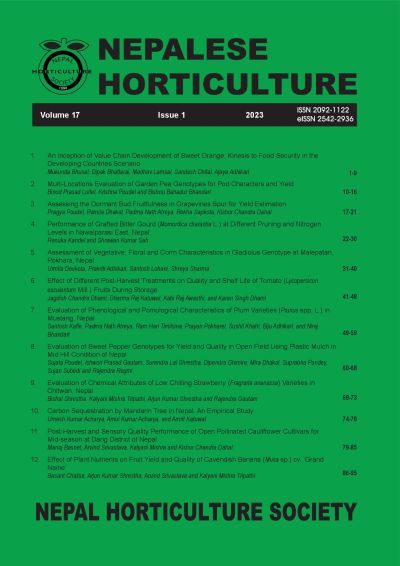Effect of Different Post-Harvest Treatments on Quality and Shelf Life of Tomato (Lycopersicon esculentum Mill.) Fruits During Storage
DOI:
https://doi.org/10.3126/nh.v17i1.60631Keywords:
Calcium chloride, Gibberellic acid, Physicochemical, Post-harvestAbstract
Tomato (Lycopersicon esculentum Mill.) is a widely consumed vegetable crop worldwide. The perishability of fruits increased due to the high level of moisture which reduces quality and shelf life. Thus, this study was conducted in Kanchanpur, Nepal from 11th July to 1st August 2022 to investigate the impact of postharvest application of various chemical substances and plant extracts on the post-harvest life of tomatoes throughout the storage. The pink stage of the Heemsohna variety of tomato fruit was harvested and dipped in various treatment solutions; 0.1 % Gibberellic acid (GA3), 1.5% calcium chloride (CaCl2), 10% Aloe vera gel, and 15% Neem leaf extract (NLE) or distilled water as control. After that, the fruits were air-dried and kept at ambient temperatures. The experiment was set up using a Completely Randomized Design (CRD) with 3 replications and 5 treatments. At three-day intervals throughout storage, the physicochemical properties and shelf life of tomato fruit were examined. The different postharvest treatments caused the changes in total soluble solids, titratable acidity, decaying loss, and weight loss to be delayed compared to the control. With 0.1% GA3 and 1.5% CaCl2, fruit had the lowest decay percentage followed by aloe vera gel and NLE. Similarly, the fruits dipped in 1.5% CaCl2, had shown maximum shelf life of 21 days. Hence, it was determined that postharvest treatment with GA3, CaCl2, Aloe vera gel, and NLE possesses the capacity to keep quality, extend shelf life, and delay spoilage.
Downloads
Downloads
Published
How to Cite
Issue
Section
License
Copyright (c) 2023 Nepalese Horticultural Society

This work is licensed under a Creative Commons Attribution-NonCommercial 4.0 International License.
© Nepalese Horticultural Society

